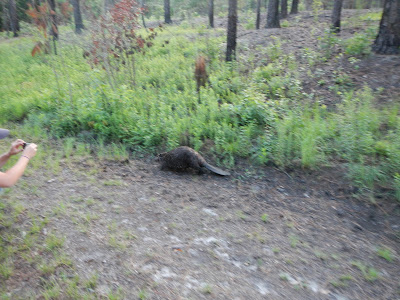We found a turtle! This is a male yellow-bellied slider. Male because it's flat on the bottom (in fancy terms his plastron is slightly concave). The theory is that this helps the males to climb on top of the females when they breed.
 |
| I like the shadow of Whitney's hands and the turtle on the ground. |
We found a small tiny lizard that tried to climb Whitney's pant leg during one of our vegetation surveys. Our best guess is eastern fence lizard. Whatever it is, it's cute.
Whitney found a land snail and brought it in the kitchen! She was outside the bunkhouse one evening making a phone call, and found this dude on the stoop. Actually, this snail might be a dudette, or both (many snails are hermaphrodites) so let's just stick with "dude."
One afternoon as we were driving back to the office, we saw a dark shape lumbering down Wildlife Drive. We first thought it might be a raccoon, but as we got closer we realized it was a beaver. We stopped the truck a respectable distance away, got out, and took some pictures. Instead of staying away from us, the beaver strolled right up, crossed the road in front of the tuck, and trundled along just a few feet away from where Whitney was crouched taking pictures. It then crossed back over the road and headed into the pond.
 |
| Close encounters of the beaver kind. |
The Beaver Song, which I learned from Chris at Aullwood Audubon Center and Farm. There are also hand motions, which I'd be more than happy to show you sometime. I only remember the chorus, which is a call and response.
Long tail (Long tail)
Big buck teeth (Big buck teeth)
Swimmin in the water (Swimmin in the water)
Chewing on trees (Chewing on trees)
Building up a dam (Building up a dam)
You know who I am (You know who I am)
I'm a Beaver, I'm a Beaver, I'm a Beaver! (I'm a Beaver. I'm a Beaver. I'm a Beaver!)
 |
| Swimming away, looking for trees to gnaw on. |
Beavers can weigh up to 60lbs, and can be 23 to 39 inches long, excluding the tail, which adds an additional 8 to 12 inches. Not something you typically expect to see trucking down a paved road in the middle of the afternoon, especially as beavers are usually nocturnal.
And these pictures don't have Whitney in them (and therefore are not nearly as interesting) but I did find this really neat insect while I was cleaning my peeper-- the telescoping camera we use to look in woodpecker cavities. Not sure what it is, but it's cool!














































